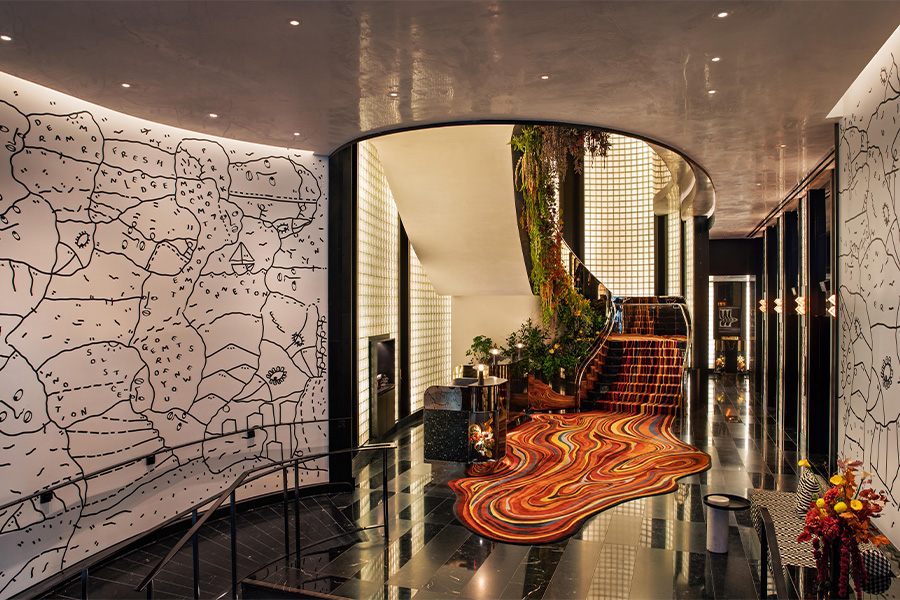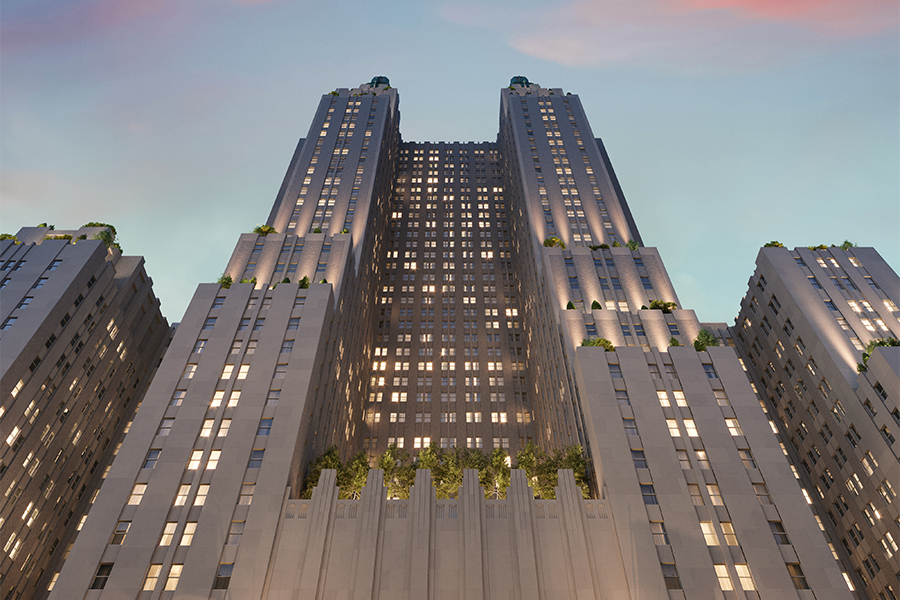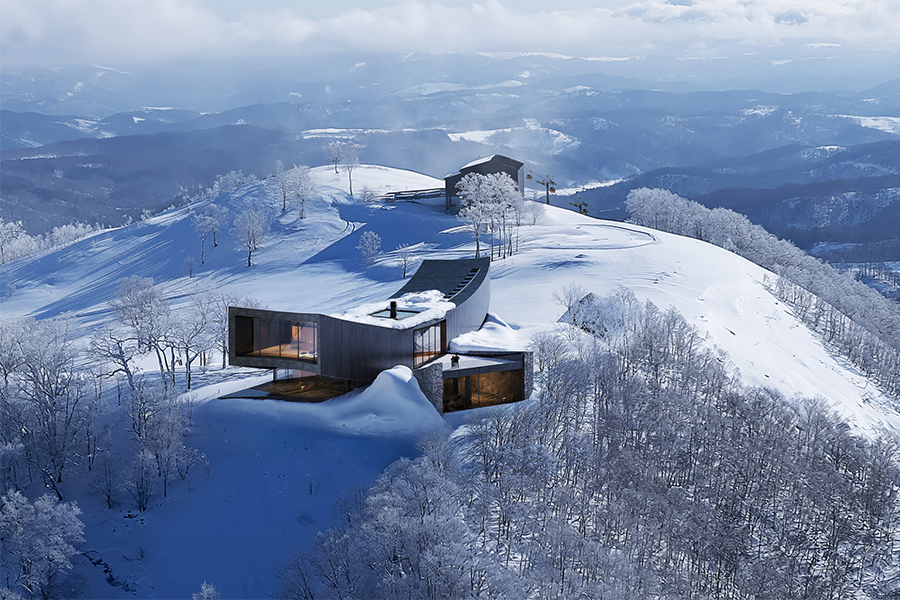Barry Sternlicht’s brazen conception for a new hotel brand manifested in 1998, when he transformed the Doral Inn into the W Hotel New York on Lexington Avenue. Sternlicht presided over Starwood Hotels and Resorts at the time (after selling the company to Marriott in 2016, Sternlicht is rebranding his current SH Hotels & Resorts portfolio to Starwood), and he envisioned W Hotels as fashion- and music-fueled properties with living rooms instead of lobbies and clamored-for Extreme Wow suites.
That first W Hotel, designed by Rockwell Group—also the New York firm’s first full-fledged hotel project—disrupted the hospitality world. “It was the beginning of the age of boutique hotels,” says studio founder and president David Rockwell, singling out Ian Schrager who also left his imprint on the city with pioneering hotels like Morgans, the Royalton, and the Paramount.
The now-shuttered W New York was in essence a sanctuary, permeating an air of lightness, and its warm textures and surprises “left you feeling better than when you got here,” recalls Rockwell.

In the W Budapest’s W Lounge, black and white motifs pay homage to the city’s chess rituals
With the advent of W Hotels, the lifestyle segment gained momentum, and over the years, the brand, which popped up in locations around the world (there are now more than 70), began to project an aura of exclusivity with a pulsating nightlife mentality.
Yet, Marriott knew it was time for the nearly 30-year-old brand to undergo a sophisticated reboot, and Rockwell Group, which had grown up alongside the brand, was primed to develop new standards that straddled lifestyle and luxury.
Today, lighthearted whimsy continues to underpin the design of W Hotels, but tactility is a priority too, as is the idea of clean maximalism. “There is an even stronger hand of local points of view and unconventional interventions,” says Rockwell. “Those are the things we thought you could weave a unique story around.”
For George Fleck, who joined W Hotels 20 years ago and is now senior vice president and global brand leader for St. Regis, EDITION, and W Hotels, “to see where W came from and where it is today is an incredible journey. W is firmly rooted in a modern luxury space it didn’t live in before,” he says. Propelling this journey, Fleck believes, is customer desire to travel on a “deeper, more enigmatic, and charismatic” level, he says.

Minus One, the subterranean cocktail bar at the W Prague, takes cues from artist Alphonse Mucha’s Art Nouveau paintings
Key to this transformation is a more elevated design that considers “the social, cultural, and historical contextual insights of each destination but still exudes the boldness, vibrancy, and colors you would expect from a W,” Fleck says.
Timeless materials, dynamic programming, and a dedication to service are all hallmarks of W Hotels 2.0. The W bars, for instance, are not merely for partying but opportunities to reinforce narratives, like Poppy, the AvroKO-designed speakeasy within Minus One at the W Prague (the London studio collaborated with Chapman Taylor on the property) that takes cues from Secessionist metal work.
W’s Away spas are also centered on wellness, a departure from the beauty-focused, on-the-go treatments of the past that spoke to “the Sex and the City era of early 2000s New York, which was right for the time,” explains Fleck. For example, the spa at the W Budapest, designed by London-based Bowler James Brindley and local firm Bánáti + Hartvig, shimmers in traditional tiles and gold mesh, an ideal environment for lingering.
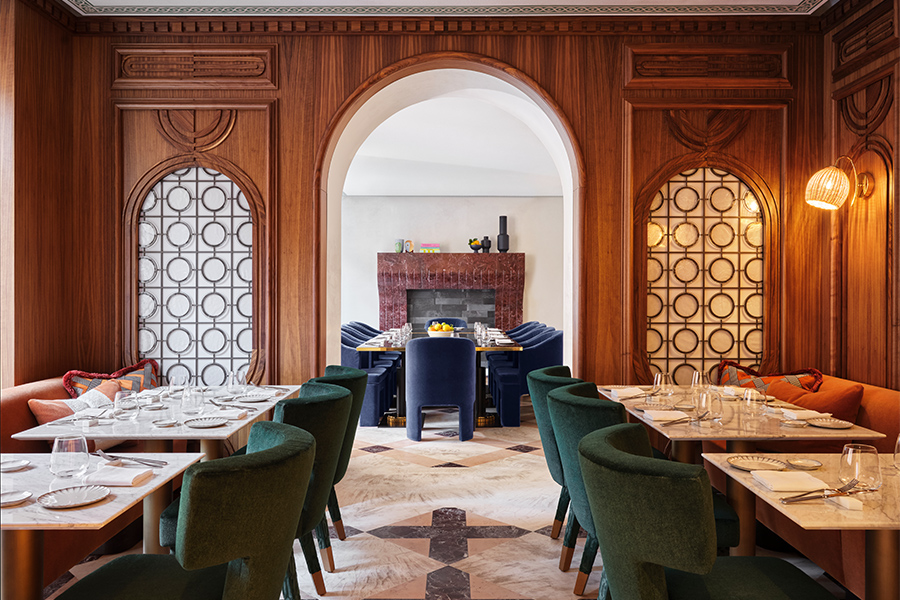
Wood and velvet wrap Giano restaurant in the W Rome
These recently opened properties “send such a strong signal of where we’re headed,” points out Fleck. There’s more to come too, including the W Punta Cana in the Dominican Republic, the brand’s first all-inclusive resort featuring a design by Coral Gables, Florida-based EoA Group and Spanish firm Zanobia Arquitectura, and the W Riyadh, courtesy of Dubai-based LW Design Group. Building upon the success of the Meyer Davis-designed W Rome, Italy is poised to become an epicenter for the brand. The New York firm is handling the upcoming W Sardinia, Rockwell Group is working on the W Naples, and AvroKO is behind the soon-to-open W Florence.
Refurbishing existing properties is also key to the W renaissance. Singapore studio Miaja Design Group recently updated the W Maldives, its overwater and beach villas informed by whale sharks and mangroves, Rockwell Group is reimagining the W Barcelona, and AvroKO is giving the W Hoboken in New Jersey a new look. “We’re keen on reimagining some of our most iconic hotels,” says Fleck, “to resonate with those who have loved the brand from the beginning.”
Here is a look at three W Hotels that symbolize the brand’s new direction.
W New York – Union Square
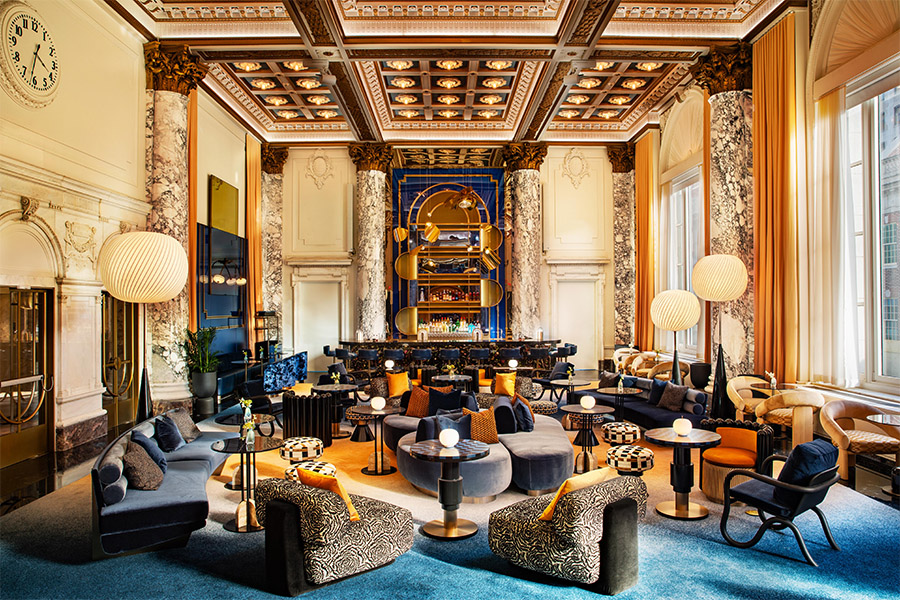
The W New York – Union Square’s Living Room celebrates the building’s original details like the florets gracing the ceiling
In 2000, the W New York – Union Square opened inside the Empire-style Guardian Life Insurance Company Building. Another Rockwell Group project, it welcomed guests with a dramatic staircase at check-in. For the hotel’s new incarnation, which the firm had the rare opportunity to reimagine again, “there was a lot of opportunity to take inspiration from Union Square Park itself, which is a place of protest, self-expression, and art—all these things that embody a spirit that parallels what W is in its soul,” says Rockwell Group partner Greg Keffer.
Undoubtedly, the most prominent change is the Living Room, which has been repositioned from the entry to upstairs in the former ballroom, “a glorious landmark space that we got to inhabit,” Rockwell adds. Other hangouts include John McDonald’s in-the-works restaurant Seahorse and a rooftop designed by AvroKO.
While the black and white ground-floor lobby, dominated by a Shantell Martin mural, signifies the city outside, the now slightly rotated signature staircase swathed in vibrant hues and bursting with botanicals promises another kind of adventure. “This pooling of color from above comes down as a magical carpet. It’s an irresistible temptation to see what’s up there,” says Keffer.
Once visitors ascend, they move their way through an intimate café, what Keffer describes as a “green-lacquered box,” and into the Living Room that brims with grand details from 1911 like the florets that cover the ceiling. They are married with a contemporary chandelier that drapes over the bar and large-scale mirrors “that almost feel like they were color-dipped,” points out Keffer.
As part of the brand evolution, W hotels are now embracing color like a material, and the W New York – Union Square’s 256 guestrooms are saturated odes to the seasons, highlighting tones like deep green and burnt orange. Keffer’s office looks onto Union Square, and those daily scenes ignited guestroom touches like lamps that call to mind the lanterns at subway entrances, nightstands that draw from the Metronome public art installation gracing a building on Union Square’s south end, and faucet handles painted a taxi-cab yellow. “It’s these little things that are a sprinkling in of the neighborhood,” Keffer says.
W Hollywood
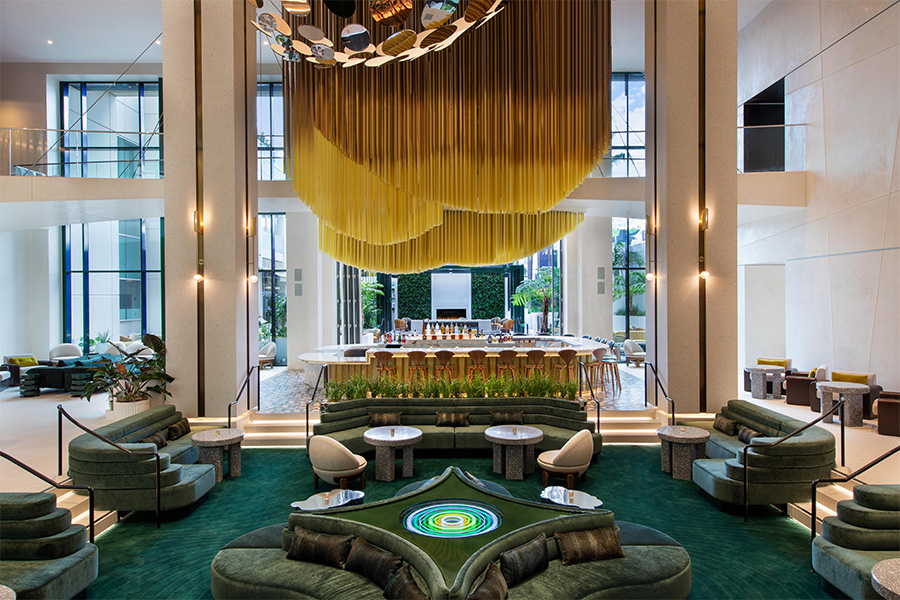
An installation of acrylic rods dips over the bar at the W Hollywood
Shawn Sullivan, partner at Rockwell Group, remembers when the firm was asked to tackle the inaugural W hotel, and to him, the overhauled W Hollywood encapsulates those “beautiful moments of the original story that find their way into the rebranding,” he says.
Consider the triple-height Living Room, complete with a sunken conversation pit buoyed by a monumental reflective mirror sculpture. The ambiance is decidedly residential, with sinuous green velvet sofas and a bar overlooking the fireplace flanked by 3D concrete drapery.
This layout reflects “how people sit and talk and gather around a kitchen counter or dining space,” Sullivan says. It’s also a celebration of the neighborhood. Above the bar, a constellation of acrylic rods tinted yellow reveals “the intersection of beautiful Hollywood homes and the energy of Los Angeles. When you come here, you won’t mistake which city you’re in,” says Rockwell.
Hollywood has markedly changed since the W landed there in 2010. It’s less gritty now, its famed Art Deco theaters joined by the likes of Netflix headquarters, but tucked into the Hollywood Hills are midcentury abodes where parties unfurl, representing an ethos of pervasive exuberance.
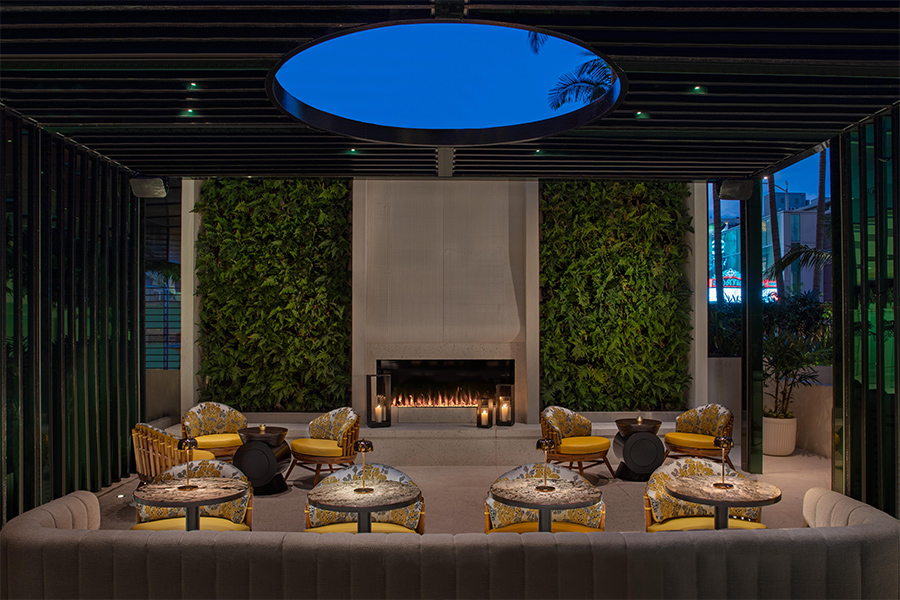
The courtyard at the W Hollywood embodies the indoor-outdoor LA lifestyle
That relaxed glamour is on full display in the courtyard (site of the forthcoming restaurant), its open walls showcasing the fluid indoor-outdoor LA lifestyle. “The golden hour is light that only exists in LA, so we played with the celestial, the colors of sunrise and sunset,” says Sullivan.
There are nods to the outdoors in the 319 guestrooms, too. So that the punched windows “have a stronger scale to them, we encased them in frames of blue-mirrored glass that expand your sense of space,” adds Sullivan. “We love the blue of an LA sky.”
Anchoring the W Hollywood in its setting is the rooftop Wet Deck, featuring a cabana-lined pool and two bars positioned on opposite ends that heighten 360-degree views of the city. “You can see the Hollywood sign on one side, and almost all the way to the beach on the other,” says Sullivan. “You get that LA sparkle.”
W Austin
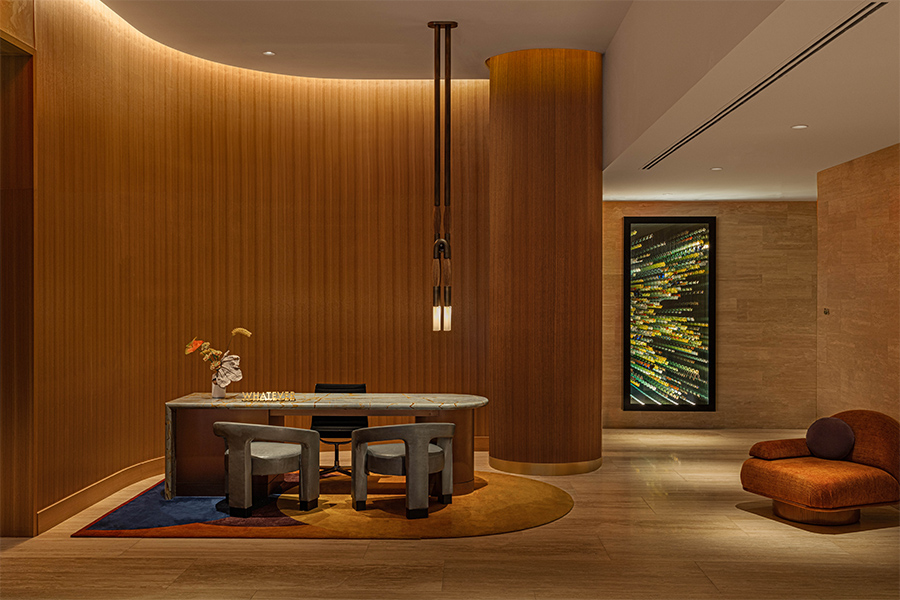
Rich veneers and butterflies pressed into infinity mirrors make an impression in the W Austin’s reception area
An endearing “Keep Austin Weird” slogan once defined the Texas capital, but in recent years, the city’s quirkiness has been overshadowed by its growth as a technology hub. Factor in its rich music history and abundance of green spaces, and it’s no wonder Austin continues to reel in visitors.
When tackling the revamp of the W Austin, part of the Opry Entertainment Group portfolio, Atlanta-based BLUR Workshop explored these motley dimensions. “Austin is this dichotomy of where laws are being made and where people are making music. If a hippie and a politician from the ’60s had a baby, Austin would be their love child,” says principal Foreman Rogers.
To capture both Austin’s roots and its present-day dynamism, Rogers and his team treated the hotel as a concert. The porte-cochère provides a buzzy red carpet atmosphere, thanks to a canopy of lights that entice guests past the façade, now dressed in vertical, light-filtering fins, into the reception area that serves as the opening act. Here, lush woods recall string instruments and butterflies sealed in infinity mirrors reference the Lady Bird Johnson Wildflower Center, a 20-minute drive away.

A canopy of wildflower prints brightens Serenade restaurant in the W Austin
It flows into the Living Room, or the headliner, as Rogers calls it, where the bar, fronted in golden Giallo Siena marble, pays homage to the Yellow Rose of Texas lore, and dangling light fixtures reinterpret lighters waved during packed shows of yore. The overall experience suggests imbibing “inside a brass instrument,” Roger says. “We didn’t need a picture of Willie Nelson to tell you that you’re in Austin.”
There’s also the ballad, the 2nd & Roast coffee bar starring custom lighting reminiscent of a saxophone, and the after-party, the moody Blue Room that feels as if it’s nestled into a piano, with a bar that evokes trumpet keys. At Serenade restaurant, BLUR leaned into Lady Bird Johnson’s affinity for the outdoors, melding a chandelier of cascading petals with wildflowers rendered in hide.
A patio and bespoke tile wall of Texan birds reinforce the notion of a garden, which carries through to the 251 guestrooms enveloped in sage green, “a color that came from walking the shores of Lady Bird Lake,” says Rogers. “We wanted to get some nature in there.”
This article originally appeared in HD’s April 2025 issue.

